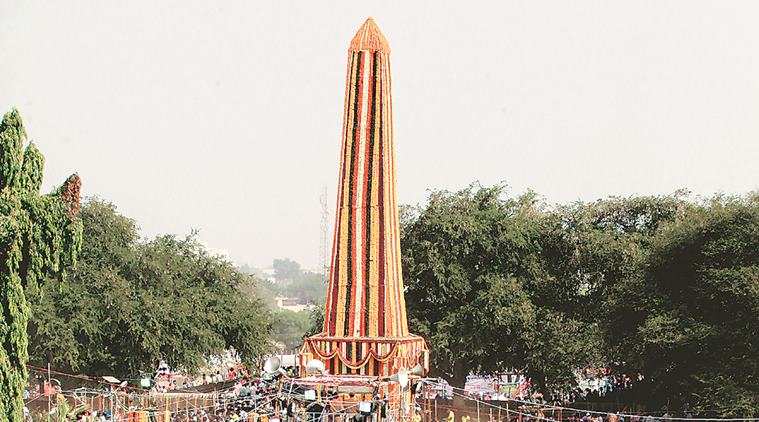 Patil said his research had revealed major discrepancies between the actual history of the Jaystambh and the one that was being published. Express
Patil said his research had revealed major discrepancies between the actual history of the Jaystambh and the one that was being published. Express
There was no ‘Mahar regiment’ in the battle of Koregaon Bhima on January 1, 1818, and neither the British nor the Peshwas won or lost the battle on that day, said journalist and researcher Chadrakant Shamrao Patil, while appearing before the Koregaon Bhima Inquiry Commission in Pune on Wednesday.
Patil had filed an affidavit on the history of the battle, along with a few hundred pages as ‘evidence’, before the Commission headed by former Calcutta High Court Chief Justice J N Patel and comprising state chief secretary Sumit Mullick. The commission was formed by the state government to probe the reasons behind the violence that broke out on January 1, 2018, in the villages near Pune, in which one person was killed and several others injured.
The commission held its first hearing in Pune on Wednesday, during which Patil claimed that the battle was the fallout of a dispute following the murder of Gangadhar Shastri Patwardhan, a minister of the Gaikwads of Baroda in 1815, by Trimbakji Dengle, a trusted lieutenant of Bajirao Peshwa II.
In his affidavit, Patil claimed that the 1818 battle was not linked to any particular caste or religion. He said while media reports after the January 1 violence had mentioned the participation of the ‘Mahar regiment’, and that the 1818 battle was fought between 500 Mahars and a 28,000-strong troop of Peshwas, these claims were doubtful.
“The Mahar Regiment was established in 1941. So, there was no question of its participation in the 1818 battle,” he said.
Patil said he had visited the Jaystambh located at Perne village on the Pune-Ahmednagar Road on January 4. He said he had researched the matter for over five months and his research had revealed major discrepancies between the actual history of the Jaystambh and the one that was being published.
He, however, claimed ignorance about the history of Jaystambh playing a role in the incidents that took place during the 200th anniversary celebrations of the Koregaon Battle
During his examination before the commission on Wednesday, Patil said he had studied books like “Military History Warfare” by John Wylie, who was a surgeon in the British Army’s Madras Artillery and who had participated in the Koregaon Bhima Battle of January 1, 1818, as well as documents from the Poona Archives, Bombay Archives and other relevant sources.
Patil, who submitted documents to support his claims, said in order to settle a dispute over the collection of revenue with Peshwas, the Gaikwads of Baroda had sent their minister Gangadhar Shastri to Pune, with British intervention. But on July 14, 1815, Trimbakji Dengle and his men killed Gangadhar Shastri, he said.
“British officer Elphinstone initiated an investigation and found Dengle and his two aides guilty of murder….Following repeated demands from British officials, Peshwas handed over Dengle to them. Dengle was jailed in Thane Fort, from where he escaped on September 12, 1816 and raised an anti-British force in Phaltan (Satara) and Khandesh, comprising Bhills, Mangs, Ramoshis, Marathas and others, using funds from Peshwas,” said Patil.
“Bajirao Peshwa II, Dengle, Bapu Gokhale, the chief of the Maratha army, and Appa Desai Nipanikar held a meeting at the Sangham Mahuli Palace in Satara and hatched a conspiracy to attack Elphinstone’s Camp….On November 5, 1817, Peshwa’s forces attacked Elphinstone’s residence in Khadki, Pune, but he managed to escape. The British Army then started chasing the Peshwas…..As per the British correspondence available in historical records, on December 31, 1817, around 8 pm, a British force of about 875, comprising the second battalion of First Bombay Native Infantry, two canons of Madras Artillery and 300 cavaliers of 17 Poona Auxiliary Horse, led by Captain Francis Staunton, was on its way to Pune from Shirur. On reaching a spot about two miles away from Koregaon, Staunton spotted the Peshwa forces on the other side of the river (Bhima). So he entered Koregaon with his forces. Bajirao Peshwa II saw this from a hillock …Peshwa sent three troops mainly comprising of 7,000 Arabs towards Koregaon….The two forces fought with each other in Koregaon, “ he said.
Patil submitted that Peshwas had an army of about 28,000, of whom 500 soldiers died in the Koregaon Battle, while the British lost 111 soldiers, including 13 British soldiers and 98 Indians.
“On January 1, when the battle was on, Peshwa fled towards Satara…as darkness fell, the battle stopped around 8 pm on January 1. On the afternoon of January 2, the British went to Shirur camp…There was neither a victory, nor a loss of any of the forces,” he claimed.
On February 19, 1818, British forces attacked Peshwas at Ashti near Pandharpur, said Patil. Months later, in June 1818, the Peshwas surrendered to the British, he added.
Patil also presented correspondence between British officials about setting up the Jaystambh in the memory of the valour of British forces in the Koregaon Battle and the appointment of Khadoji Maloji Jamadar (Malvadkar) as its caretaker.